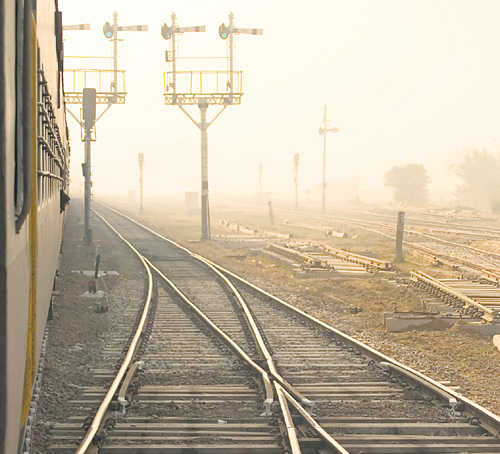Former Revenue Secretary D.K. Mittal may well turn out to be the ‘knight in shining armour’, rescuing Railway Minister Suresh Prabhu by helping him to take some tough and highly unpopular decisions in order to put a brake on the Indian Railways hurtling towards financial bankruptcy.
Realising that the Bibek Debroy committee on railway reform and restructuring set up last year may take quite some time to come up with a set of its recommendations and pressed for urgent inputs for his forthcoming maiden rail budget, Suresh Prabhu ordered a new high-level committee on improving the financial health of the Railways which has fortunately recommended what in any case he was planning to do.
At present the average revenue per passenger km for ordinary second class is a mere 13.80 paise, 14.54 paise for suburban trains, 27.47 paise for second class Mail /Express and 109.47 paise for upper class, making the Indian Railways perhaps the cheapest rail transport system in the world.
A hike in passenger fares has long been overdue, what with the successive railway ministers over the last two decades steadfastly refusing to bite the bullet. The Mittal committee has recommended an empowered committee to be set up for reviewing passenger tariff with an objective of achieving the recovery of at least the cost of operations.
A policy framework where fares can be increased at 25 per cent of the consumer price index announced by the RBI on a quarterly basis, and a 2 paise per km hike for second-class fares, including the suburban and inter-city trains till the break-even point is reached, has also been suggested.
These hikes, somewhat on the lines of the petroleum products, which saw a gradual increase in petrol and diesel prices by almost 40 per cent over the last three years, reducing the losses suffered by petroleum companies, would do the same for the rail passenger segment, which was 10 paise per km in 2000-01 and had ballooned to 23 paise in 2012-13.
In just 23 days the committee with representatives of some of the big names in the corporate management world viz. KPMG, McKinsey & Company, Ernst & Young and Boston Consultancy Group India Ltd., and a few highly successful railway PSUs viz. IRCON, RITES and CONCOR on board, has come up with hundreds of short and long-term suggestions.
It also met and interacted with dozens of stakeholders, including Coal India, SAIL, NTPC, FICCI, CII, ASSOCHAM, Ministry of Commerce, CRIS (Centre for Railway Information Services), IRCTC ( Indian Railway Catering & Tourism Corporation), RVNL (Rail Vikas Nigam Ltd) and Railtel, for critical inputs.
However, with a rather short time frame at its disposal and the extensive canvas to be covered, the committee has ended up with mainly the wish list of various stakeholders.
Its recommendation that “No expenditure should be allocated for any project till it has passed through the critical evaluation scrutiny from the point of view of viability and prioritisation” is a basic necessity for ensuring the financial health of any organisation, but had in the past been routinely ignored by some of the railway ministers who called these unviable projects as ‘socially desirable’ for which, in their opinion, such a scrutiny was not mandatory.
It is now for the Railway Board and ultimately Suresh Prabhu to sift through the long list of proposals and decide what is implementable and at what cost, so as to get the maximum bang for their bucks.
However, one of the most significant recommendations is the urgent need for the completion of 24 corridors and seven feeder routes, about which Railway Board mandarins have been crying hoarse for almost a decade now.
The successive rail ministers' penchant for earning applause by announcing scores of new projects every year has unfortunately resulted in spreading the available resources thin, with not much return in sight. As a result, progress on these projects has been painfully slow.
Now Rs 95,000 crore, excluding the electrical and signalling and telecom works, and another Rs 65,000 core to optimise the output of these corridors (a grand total of Rs 1,65,000 crore) will be required to complete them.
Basically involving doubling, gauge conversion, new lines, electrification and signalling they are all vital for carrying increased levels of freight, the Railways’ bread winner. With the current level of budgetary support of Rs 30,000 crore a year, an additional amount of Rs. 1,50,000 crore will be needed for the next three years.
Four working groups have deliberated on passenger and traffic services, freight traffic services, monetisation and additional resource mobilisation, long-term finance, productivity and efficiency — a fairly wide range of subjects to cover.
Apart from some suggestions about monetising the Railways’ vast land bank which has been on its agenda for a decade now with not much headway and a few new gimmicks such as naming trains and stations after corporate houses to earn advertising moolah, the committee has placed its hopes on enhanced budgetary support from the central exchequer for raising long-term finances.
One of the suggestions for a new format of dynamic pricing, on the lines of air tickets, for some of the trains designated as ‘premium’ could boost earnings, while online ticketing to be done only through the IRCTC website should help eliminate touts and fictitious bookings.
The setting up of an independent committee to review the operation of loss-making trains to assess their potential and consider options to make them viable has been suggested. Facing continuous losses, perhaps these trains may need to be discontinued, not a very popular decision but inescapable for regaining the Railways' financial health.
Ultimately it will be up to Suresh Prabhu to bell the cat.
The writer is a former member of the Railway Board
Unlock Exclusive Insights with The Tribune Premium
Take your experience further with Premium access.
Thought-provoking Opinions, Expert Analysis, In-depth Insights and other Member Only Benefits
Already a Member? Sign In Now










